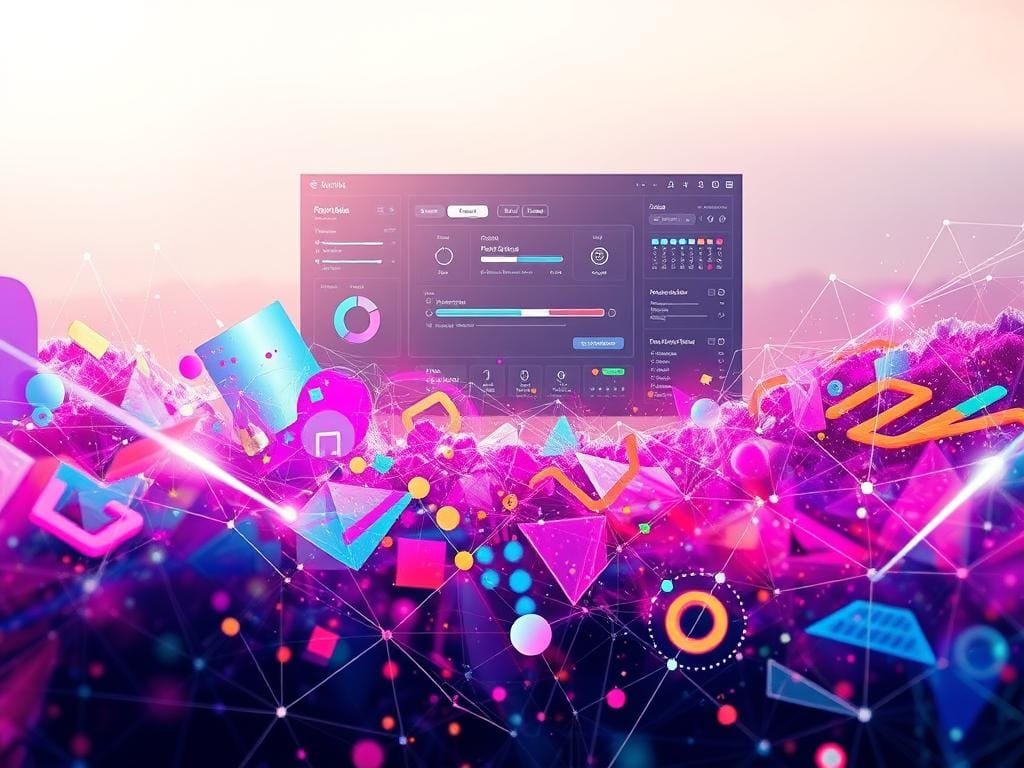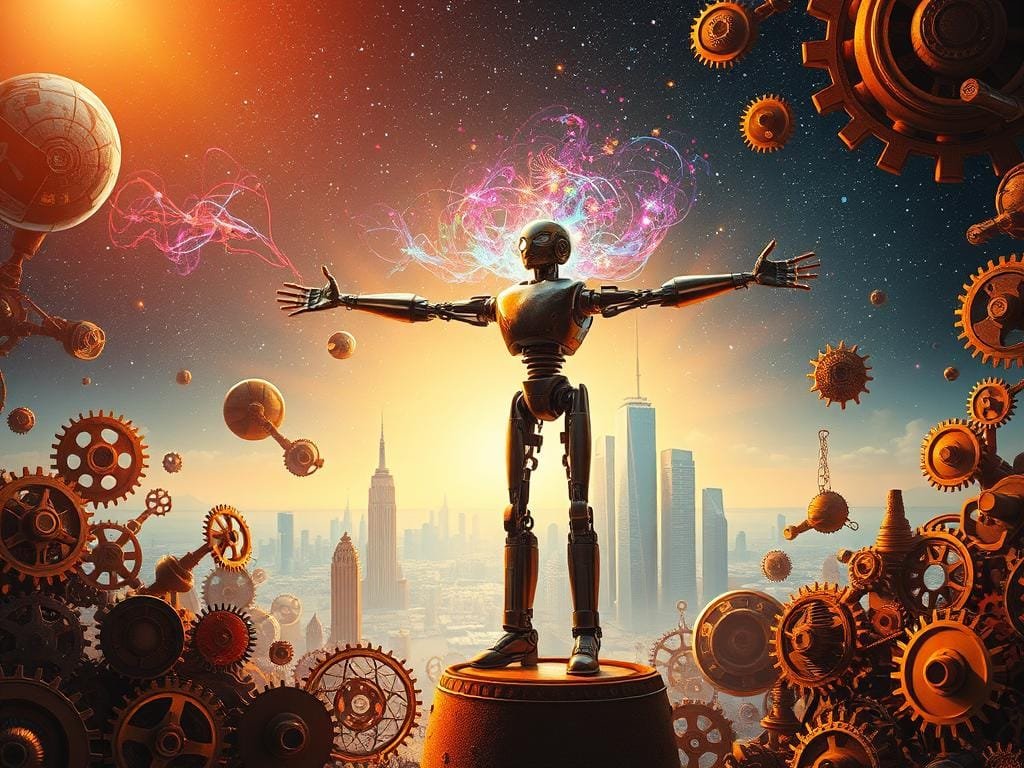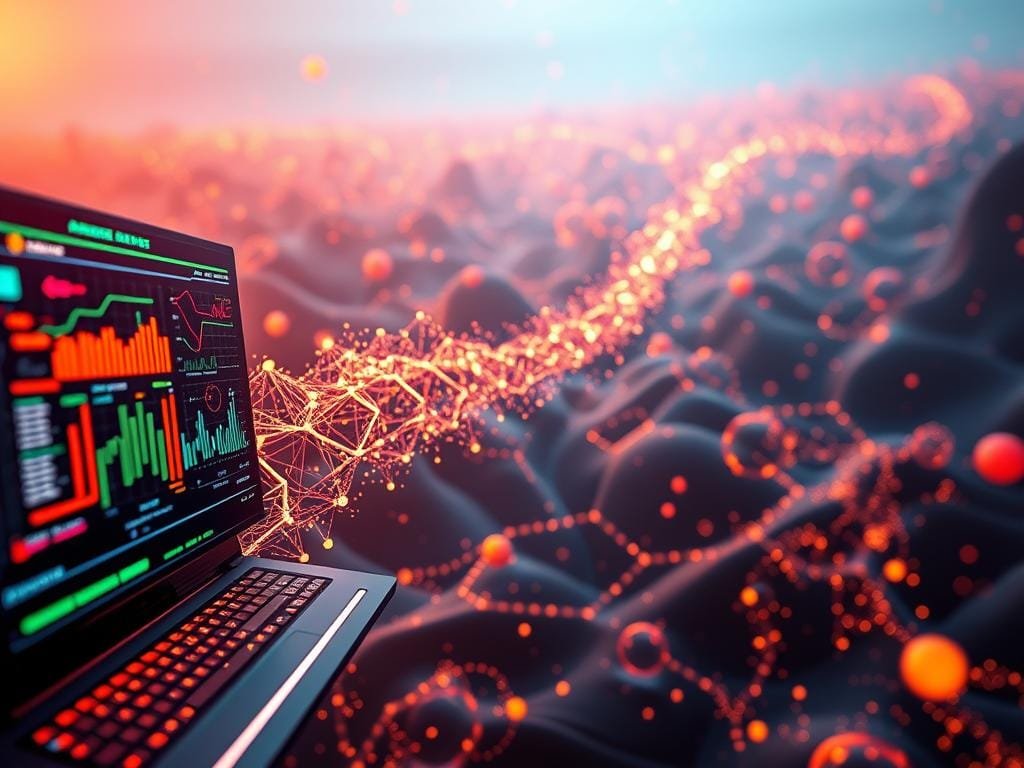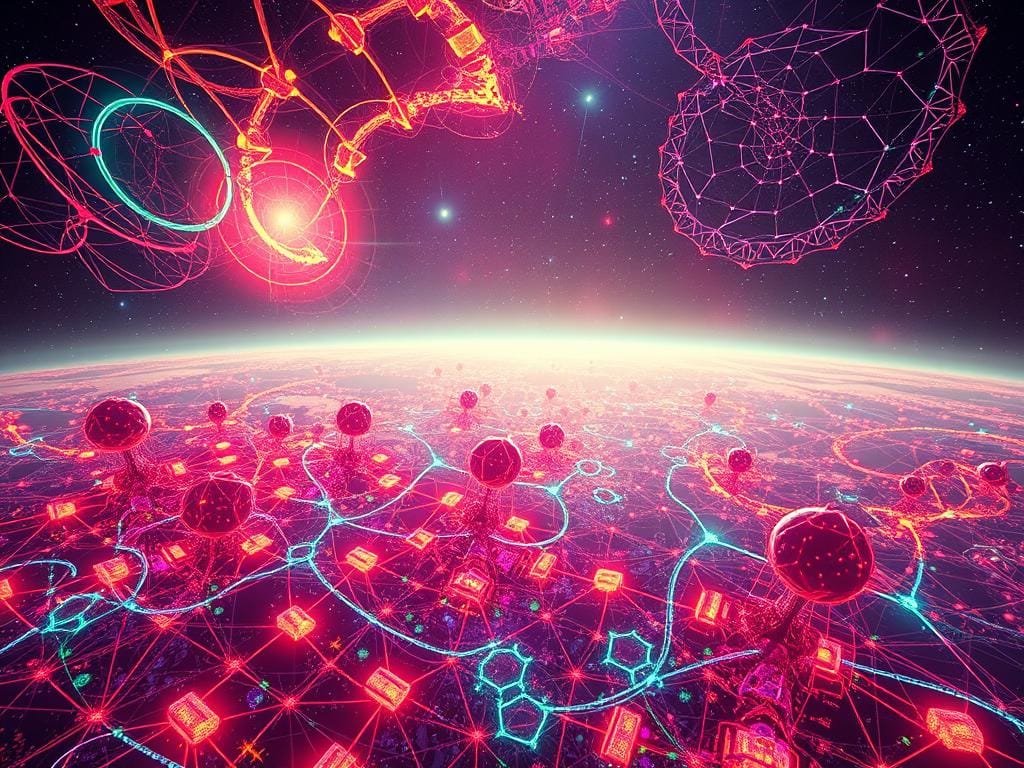The art world is buzzing with AI-generated art, sparking debate. AI algorithms are getting better, making art that’s as good as human-made.
Can machines really be creative? It depends on what artificial intelligence can do in art. This article will show how generative AI is changing the creative world.
Key Takeaways
- The rise of AI-generated art is redefining the boundaries of creativity.
- Artificial intelligence is being used to create innovative works of art.
- The future of AI in art holds much promise, with applications in various creative fields.
- As AI technology advances, it will likely change the art world a lot.
- The mix of human and machine creativity is an exciting area to explore.
Understanding the Intersection of AI and Creativity
Exploring AI’s creative side shows how algorithms are changing art. Machine learning and creative algorithms are making new ways to create art, music, and stories.
The world of creativity is changing with AI. But what does this mean for artists, musicians, and writers? Let’s look at how AI is changing creativity.
What Does AI Mean in the Creative World?
In the creative world, AI uses complex algorithms to make art. This includes generating musical compositions and visual art pieces. AI can look at lots of data, finding patterns and styles that humans might miss.
For example, AI can learn from famous painters and make new art in their style. This has sparked both excitement and debate. You can learn more about AI’s creative side in articles like the one on Forbes, which talks about AI and human creativity.
The Role of Algorithms in Artistic Processes
Algorithms are key in AI’s creative work. They help machine learning models make art, music, and stories. These algorithms can be different types, like:
- Generative models that create new content based on learned patterns.
- Predictive models that forecast trends or outcomes in artistic endeavors.
- Analytical models that provide insights into existing artworks or creative processes.
These algorithms do more than just make art; they help human creators too. They automate tasks, suggest ideas, or even work together in making art. For more on AI in apps and machine learning, check out Digital Vista Online.
Knowing how AI and algorithms work in creativity helps us see their power and limits. It shows how they can help or change human creativity.
Historical Context: AI in Art
The journey of AI in art started with early computer-generated art experiments. From the 1970s, innovative technology has been key in shaping art. At first, using algorithms to make art was doubted, but it led to big steps forward.
Early Experiments with Computer-Generated Art
In the beginning, computer art focused on simple shapes and graphics. But with the growth of neural networks, art became more complex and detailed. New algorithms let artists explore new creative areas.
One key effort was making visual patterns with algorithms. Then, artists started experimenting with music and other art forms. These early steps paved the way for today’s AI art systems.
Milestones in AI Art Development
There have been key moments in AI art’s growth. The creation of Generative Adversarial Networks (GANs) was a big leap, making images look very real. Also, AI art platforms started, letting artists work with machines.
| Year | Milestone | Description |
|---|---|---|
| 1970s | Early Experiments | Initial forays into computer-generated art, focusing on geometric patterns. |
| 2014 | GANs Introduction | Generative Adversarial Networks revolutionized AI-generated art with highly realistic images. |
| 2018 | AI Art Platforms | Platforms emerged that allowed artists to collaborate with AI, creating new forms of art. |
AI’s role in art is growing, and its history is key to understanding today’s AI art. It shows how AI art has evolved and what’s next.
Current Applications of AI in Creative Industries
Artificial intelligence is changing creative industries in big ways. You might already see AI’s work in media and art. It’s everywhere.
AI is now a big part of many creative fields. It changes how we make, enjoy, and talk about art, music, and stories. AI can make music, art, and even write stories, changing what we think of as creative.
Music Composition and AI
AI can now make music that sounds great and is new. You can find AI music in many styles, from old to new. It’s a mix of human and machine creativity.
AI tools look at lots of music, learn, and then make new songs. This team-up of humans and AI can make music we’ve never heard before.
AI-Driven Visual Arts
AI is also changing visual arts, making art from simple to complex. You see more digital artistry as AI helps artists try new things. It’s changing what we think of as art.

AI visual arts include cool things like style transfer. It changes one image into another, making art that’s both interesting and strange. Artists use these tools to grow their creativity.
Literature and Content Creation Through AI
AI is also affecting writing and content making. It can write everything from news to stories. You see AI in media and marketing too.
AI can help writers by suggesting ideas and even whole stories. It’s great for those who want to work faster or try new things. For more on AI in web development, check out Generative AI in Web Development.
As AI gets better, it will help more in creative fields. It opens doors for artists, musicians, and writers to work with machines. This could lead to new and exciting things.
The Debate: Can Machines Be Creative?
When we talk about creativity and machines, big questions come up. Can machines really make original art? As we look into artificial intelligence, we face a big debate. Is it possible for machines to be truly creative?
Defining Creativity in the Context of AI
Creativity means making new and useful ideas. In AI, it’s about using complex algorithms to make art, music, or stories. You might ask if AI’s creations are really new or just complex math.
Key aspects of creativity in AI include:
- The ability to learn from existing data and generate new content
- The capacity to recognize patterns and create novel combinations
- The ability to innovate and surprise human observers
Comparing Human Artists to AI Production
Human artists and AI systems are different. Humans create with their feelings and experiences. AI works with algorithms and data. Can machines really do what humans do in the creative process?

- Can AI systems truly be considered creative, or are they just using existing data?
- How do human emotions and experiences shape creativity, and can AI mimic this?
- What does AI-generated art mean for the future of creative jobs?
The debate on whether machines can be creative is complex. It makes us think differently about art and human creativity in the age of AI.
The Technology Behind AI Creativity
AI’s creative power comes from its tech base, including machine learning, neural networks, and GANs. These tools help AI systems study huge amounts of data, learn from it, and create new content.
Machine Learning and Neural Networks
Machine learning is a part of AI that trains algorithms on data. This lets them predict or create content without being told how. Neural networks, like the human brain, are key in machine learning. They have layers of nodes that process and share information.
For more on these techs, check out Quanta Magazine. It dives into AI creativity research.
Neural networks are great at spotting patterns in data, like images or text. By learning these patterns, AI can create new content that looks or sounds similar. For example, AI can learn from paintings to make new art that looks like the originals.
Generative Adversarial Networks (GANs) Explained
Generative Adversarial Networks (GANs) are a big step forward in AI creativity. They have two parts: a generator that makes new content, and a discriminator that checks if it’s real. This back-and-forth process makes GANs create content that looks very real, often like it was made by a human.
Training GANs is like a game where the generator and discriminator compete. This competition makes both networks get better, leading to more advanced content. For instance, GANs can make realistic portraits, landscapes, and even videos.

| Technology | Description | Application in AI Creativity |
|---|---|---|
| Machine Learning | Algorithms trained on data to make predictions or generate content. | Enables AI to learn from data and generate new content. |
| Neural Networks | Layers of interconnected nodes inspired by the human brain. | Recognizes patterns in data to generate new content. |
| GANs | Two neural networks working in tandem to generate realistic content. | Produces highly realistic images, music, or text. |
Noteworthy AI Art Projects
AI art projects have shown how algorithms can create stunning and thought-provoking art. You’re about to see some key examples that have changed digital art.
OpenAI’s DALL-E and Image Generation
OpenAI’s DALL-E is a groundbreaking AI model that makes images from text. Just type a sentence, and DALL-E will create an image. This tech has opened up new ways for creative expression and has sparked lots of talks about AI art.
Google’s DeepDream and Surreal Imagery
Google’s DeepDream is another famous project. It uses a neural network to make surreal, dreamlike images. DeepDream changes existing images into unique and captivating visuals, exciting both art lovers and tech experts.
Let’s look at some key features of these projects:
- DALL-E’s ability to create a wide range of images from text prompts, showing its versatility.
- DeepDream’s power to turn regular images into surreal art, showing the creative power of neural networks.

These projects show what AI can do in art and inspire new digital artistry. As we explore AI and creativity, the future looks bright for artists and tech people.
Pros and Cons of AI in Creative Fields
Exploring AI in creative fields, we must consider both sides. AI in art, music, and literature has sparked debate. Artists, tech experts, and critics all have opinions.
Advantages of Using AI Tools
AI tools bring many benefits to creative fields. They can automate repetitive tasks, letting humans focus on creative ideas. For example, AI can help with color correction and formatting.
AI’s cognitive computing lets it analyze huge amounts of data. This can inspire new ideas. AI can also work with artists, suggesting new directions.
- Enhancing creativity through data-driven insights
- Streamlining production processes
- Enabling new forms of art and expression
Potential Drawbacks and Ethical Concerns
But, there are also downsides and ethical issues. One big problem is job displacement as AI does human tasks. This makes us wonder about the future of human creatives.
Another issue is authenticity and originality of AI content. As AI gets better, it challenges what we think of as creativity. This leads to debates about AI’s role in art.
“The increasing reliance on AI tools in creative industries prompts us to rethink the very notion of creativity and the role of human artists.”
There are also ethical concerns. For example, AI algorithms can be biased. There’s also the risk of AI content being misused.
Collaboration Between Humans and AI
The partnership between humans and AI is changing the creative world. It’s opening up new ways for artists to express themselves. With AI getting smarter, artists are finding new ways to use these tools in their work.
This mix of human creativity and AI power is creating new art forms. It’s also changing how we think about creativity.
How Artists are Partnering with AI Tools
Artists are now working with AI in many ways. AI helps from the start of an idea to the final product. For example, AI can look at lots of art and give new ideas.
You can learn more about this partnership on the Bologna Business School website.
AI in art isn’t just about making things. It’s also about how art reacts to people. Artists are making art that changes with who looks at it, thanks to AI.
This makes art more interactive and engaging for viewers.
Case Studies of Successful Collaborations
There are many examples of AI and humans working together well. For instance, “Edmond de Belamy,” an AI portrait, sold for $432,500 at Christie’s. Another example is “Amper Music,” which makes music with AI.
These show how AI can be used in many creative ways.
| Project | Description | Outcome |
|---|---|---|
| Edmond de Belamy | AI-generated portrait by Obvious | Sold at Christie’s for $432,500 |
| Amper Music | AI music composition tool | Creating customized music tracks |
| DeepDream | Google’s AI project for surreal imagery | Generated surreal and dreamlike images |
By working with AI, artists are improving their work and exploring new ideas. As machine learning gets better, we’ll see even more amazing uses of AI in art.
Future Prospects of AI in Creativity
AI is making a big splash in the art world. It’s important to think about what’s next for creative fields. Neural networks and creative algorithms will be key players in the future.
Emerging Trends and Innovations
AI’s future in creativity will bring big leaps in machine learning and neural networks. These will help create AI tools that work better with humans.
New trends include better generative adversarial networks (GANs) and AI working with augmented reality (AR) and virtual reality (VR). These changes will bring new ways to express creativity.
The Future of Creative Professions
AI’s role in creative fields will bring both chances and challenges. AI can do routine tasks, giving humans more time for creative work. But, people will need to learn new skills to work well with AI.
The future will see more collaboration between humans and AI. Creative algorithms will help generate new ideas and boost human creativity. Those who can work well with AI will do well.
- Learn about AI and machine learning to stay current.
- Use AI tools to improve your creativity and work efficiency.
- Focus on the creative decisions that AI can’t handle yet.
By embracing these changes, creative professionals can not only survive but also flourish in an AI-driven world.
Conclusion: The Evolving Nature of Art and AI
Art is changing fast, with AI playing a big role in digital art. This new tech is helping humans create more and explore new ways to express themselves.
Human Touch in AI-Driven Art
AI can make amazing art, but it’s missing something special. That something is the human touch. Artists bring their own feelings and stories to their work, something AI can’t do yet.
AI as a Collaborative Tool
Artists can use AI to help them, not replace them. This way, they can make something truly new and exciting. It’s a mix of human creativity and AI’s power, thanks to new tech.
FAQ
What is the role of AI in the creative world?
AI is changing the creative world. It’s used in music, visual arts, and literature. It creates new content with machine learning and neural networks.
Can machines be truly creative?
The debate on machine creativity is ongoing. Some say AI can make new and valuable content. Others believe true creativity is human, and AI just processes data.
What is the technology behind AI-generated art?
AI art uses Generative Adversarial Networks (GANs) and neural networks. These technologies let algorithms learn and create new content, like images and music.
What are some notable AI art projects?
OpenAI’s DALL-E generates images from text. Google’s DeepDream creates surreal images with AI. These projects show AI’s power in art.
What are the benefits and drawbacks of using AI in creative fields?
AI brings efficiency and new ideas to creativity. It can generate unique content. But, it might replace jobs and raise ethical questions.
How are humans and AI collaborating in creative projects?
Humans and AI work together in projects. Artists use AI for ideas and to automate tasks. This leads to innovative works that show the power of human-AI teamwork.
What is the future of AI in creative industries?
AI’s future in creativity will be shaped by new trends and models. We’ll see more advanced AI tools and new business models. This will change the creative world.
Will AI replace human artists and creatives?
AI will change the creative industries, but won’t replace humans. AI is a tool to support human creativity. It highlights the value of human imagination.






